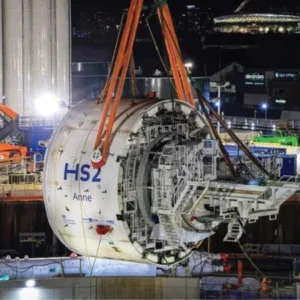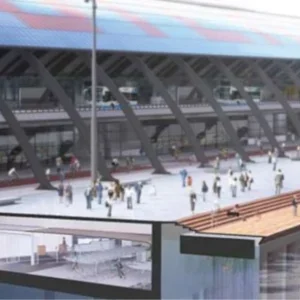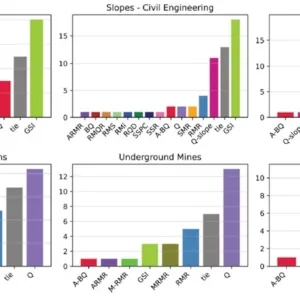On winning a second tunneling contract on the East Side Access (ESA) rail project in New York, joint venture contractor Dragados/Judlau decided to minimise the drill and blast needed for large cavern excavations below Grand Central station by taking advantage of a pair of TBMs already in the ground to drive the approach tunnels.
But while the logistical demands on drill and blast mining would be dramatically reduced, the contractor, having already faced a significant logistical challenge in getting the TBMs and backups below ground, was going to double the number of drives. The change would demand repeated, and phased, recoveries and retractions of the machines.
With the bores underway, stretches of weaker ground have led to slower progress at times for the TBMs, both advancing and when pulling through heavily-supported areas, further complicating the logistical challenge. But the majority of the 10km (approx.) of tubes have been bored. One TBM has completed its work, and the caverns are being opened up further, albeit more slowly than planned, and a major push is underway to accelerate progress.
The ESA project
ESA is being developed by the New York’s Metropolitan Transportation Authority (MTA) to join Long Island Rail Road (LIRR) via Queens and East River to Grand Central station in Manhattan. The project is a resurrection of a plan, stalled due to lack of funds in the ‘70s, but leaving a 2.6km long tunnel from Queens to the edge of Manhattan, partly twin bore and also including an immersed tube in the East River.
The resurrected scheme, which is budgeted at approximately USD3bn, involves tunnelling works at either end of the existing tunnel, in Manhattan and Queens.
MTA’s Capital Construction (MTACC) division is being supported on three levels by consultants: URS on programme management; a JV of Parsons Brinckerhoff, STV and Parsons as general engineering consultant (GEC); and, a JV of Jacobs’ Edwards & Kelcey division with LiRo on construction management services.
Manhattan Approach Tunnels
The major tunnelling works in Manhattan are the Manhattan Approach Tunnels (MATs) to Grand Central and two caverns below the station that will form a new terminal, currently due in service by late 2016. The distance from the existing tunnel that includes the MAT stretch, the station and extends to the dead-end tail track tunnels beyond, is 2.2km.
ESA’s myriad tunnels and caverns in Manhattan are excavated in schist and gneiss, the underground structures ranging in depth from about 25m-52m and in a high water-table.
MTACC let the MATs and cavern packages as separate contracts, CM009 and CM019, respectively. Both contracts were won by Dragados/Judlau in late 2006 and early 2008. The JV then integrated the excavation plans for each contract.
Under CM009, the approach tunnels are designed as parallel tubes that then bifurcate into upper and lower bores. To construct a tunnel pair, a tube is bored to a terminal cavern and the TBM retracted as far back as a GCT5 wye (“Y”) junction, which by then will have been opened up. The first tube forms the upper tube, and TBM is relaunched to bore the lower tube. There is a 131m long wye for each tunnel.
In terms of layout, near the ends of each drive are structures that will enable track switchovers for trains entering and leaving the future terminal, which will have eight platforms served by the four tubes. The shotcrete-lined structures, therefore, are common to the different TBM drives at key points and sometimes require concrete plugs for launches. They are:
• crossover caverns (GCT3-upper level, GCT4-lower level), which are 97m and 119m long, respectively, and are up to 15.8m wide and range from range in height from 7m-10m; and,
• further wyes (GCT3-upper level, GCT4- lower level), which are each 97m long.
Geology along the alignments of the MATs comprises schist with gneiss, granite and marble of UCS 80MPa to more than 200MPa, and they belong to the New England Upland or Manhattan Prong formation.
TBMs – Back & Forth
Two 6.7m diameter hard rock TBMs were acquired for the contract – a Robbins main beam and a refurbished double-shield from Seli, originally manufactured by Robbins. Tunnel support is in situ concrete in the worst areas and elsewhere ribs, bolts and mesh, in addition to grouting following probing and draining. The final concrete lining is to 5.95m diameter.
Getting the bores started was a logistical challenge in its own right. The contractorcould not open up large assembly caverns for the TBMs and backups due to restrictions from neighbourhoods, limited available space and the proximity of live subway tunnels. There were also some restrictions on using drill and blast.
A further complication was the assembly chambers being so close and having weak rock separating them, holding up part of the drives, and calling for reduced gripper and thrust pressures when TBMs were launched; first the Seli TBM and then the Robbins machine, in late 2007.
The Seli TBM was launched on the eastbound tube with a preliminary configuration. After 200m the machine had advanced to reach its final configuration.
Robbins’ TBM was designed for a twostage assembly process with a long, inner core brought into the small chamber where the outer parts, including sections of cutterhead, had been pre-positioned in a ring in the chamber.
So, another design feature of the TBMs was to have them capable of being retracted along the bored tunnels while enabling the trackwork, utilities and initial supports to be kept in place, with only ventilation ducting requiring deflation. The Robbins TBM could be stripped back to its inner core with a reduced cutterhead just over 6m wide, and the shielded front section could be folded and the front shoe collapsed. Seli’s shield has a self-collapsing arrangement of retractable shield cans.
Bores multiply
The joint venture won the CM019 (Manhattan Structures 1) contract only a few months after both TBMs got underway. The main works are the terminal caverns but additional activities include building shafts, escalator wells, air plenums, cross passages and, beyond the terminal caverns, the GCT1 & 2 wyes and tail track tunnels, which are dead-ends for switchover of trains.
The terminal caverns are about 35m long by 18.3m wide and 21.3m high, and the finished structures will have cast-in-place concrete arch roofs that are self-supporting off rock ledges. The GCT1 & 2 wyes are 100m long and vary in cross section at 9.1m-15.5m and heights of 18.3m-19.8m.
Simply, the joint venture’s plan was to take the four tubes already approaching the caverns under CM009 contract and form further bifurcations for each. This would result in eight bores through the caverns and then, beyond, they would be returned to four tubes for the tail track tunnels.
The new boring sequence would begin, as before, with the upper drive approaching the cavern and it would proceed further, be retracted to a GCT3 wye – by then partly opened up – and relaunched. These would be drives 1 & 2 (D1 & 2). Either could be the short tube passing only through the cavern or the long tube, which includes excavation of a tail track tunnel.
The TBM would then be retracted all the way back along the original approach tunnel to a GCT5 wye and relaunched again to bore the lower approach tube. The same procedure at the cavern would create drives D3 and D4.
In the tunnel drive layout plan (Fig 1B), the respective tubes by the Seli drives (SD) and Robbins drives (RD) are shown as SD1-4 and RD1-4. So, in total the sequence has four launches for each machine, and temporary concrete plugs are used in opened junctions to help the process. The first of the two Robbins drives at each level of the west bound terminal cavern were the longer of its tube pairs whereas, for the overall sequence, it was the opposite for the Seli shield.
The cavern excavations are proceeding with mining methods following the TBM bores. A series of headings and benches will take out the remaining rock, and all top TBM bores have been completed.
Progress
Aside from the logistics of the multiple TBM movements – including when a TBM having to await others due to the need to remove concrete plugs at junctions, the progress of the tunnelling works have sometimes faced challenges of weaker ground than anticipated. This caused further problems to retract through heavy supports in places, sometimes needing other structures.
The mining operations in the terminal caverns have been progressing slower than planned, and changes to activities and sequences are helping to pick up the pace.
MTA’s most recent available quarterly report on the project to the Federal Transit Administration (FTA), covering Q1 to March, says the last of the eight bores – SD4 – is due to finish by mid-2011. The SD3 bore is almost finished, and the RD bores were completed two months ago.
Progress – CM009
While the two contracts, CM009 and CM019, are proceeding with an integrated excavation plan, the Q1 report to FTA notes that substantial completion of the main bores and other underground structures under CM009 is expected in September 2012, slightly later than the already revised target of April that year.
The June report to the MTA Capital Program Oversight Committee (CPOC) notes that TBM excavation under CM009 was one per cent ahead of its planned excavation rate and that overall work was 70 per cent complete. The TBM work was within the latest revised schedule and does not put pressure on the substantial completion date.
The cost expenditure for CM009 was noted as being on target at just over 68 per cent. The original contract award was USD 427.9M, the current approved contract was USD 443.4M at the end of Q1 and the estimated final value of the contract is USD 450.3M.
Progress – CM019
From the Q1 report to FTA, the forecast and target dates for substantial completion on CM019 are September and April 2012, respectively. The original target deadline was about March/April 2012, and the revised programme had reset it to August.
Underground excavation was, by late May, almost 20 per cent complete, excluding the contribution by TBMs and activities at Madison Yard, notes the June CPOC report. It adds that cavern excavation rates have exceeded the baseline assumption, helping to regain some lost time in the overall tunneling works.
However, it notes further that the overall rate for non-TBM excavation was only about three-quarters the planned rate. The rate was an improvement over the excavation having been 28.5 per cent behind the planned volume, as noted in the March CPOC report. Most delays were blamed on works in the East Cavern, which is on the critical path of the CM019 contract.
The milestone of completing the top heading of the West Cavern is forecast to be achieved in November, slightly ahead of plan. To pick up pace, a revised approach to excavation, trialled on the East Cavern, is now being employed which involves using a crusher as well as parallel excavation by roadheader and drill-and-blast.
In addition, delayed current activities including work at locations such as cross passages, wyes and other ancillary spaces started over April/May with resources then made available, it says. To help progress further, MTA has also relaxed the blasting criteria and provided the contractor with greater flexibility, it notes in the March CPOC report.
In the June CPOC report, it was noted that excavation would resume over May/June in the top heading of the tail tracks, GCT3 crossover and GCT1 & 2. This quarter, excavation is to get going again at other locations including GCT4 as well as GCT 5 (on CM009).
The original contract award for CM019 was USD 499.9M, and by the end of Q1 that actual cost expenditure was below plan. The current approved contract value, at the end of Q1, was USD 528.4M and, assuming contract options will be exercised, the final value of the contract is estimated at almost USD 780M.
Progress – Options Ahead
The Q1 report to FTA notes that the client’s project team was working with the contractor on both contracts to mitigate delays and recover schedule, such as not retrieving the TBMs via the Queens pit but instead possibly burying them.
Also, cost saving opportunities were being checked on contract CM009, such as using shotcrete as a final liner for nonuniform structures and a revised geometry of the GCT3 and GCT5 wyes. On the contract CM019, potential cost savings from revising the geometry of GCT4 were also under review.
Figure 1A – Map of the new tunnels in Manhattan and Queens to connect with the existing Long Island Railroad (LIRR) tunnel Figure 1B – Tunnel drives layout plan and sections through chambers The Seli TBM holes through at the 37th St ‘wye’ Behind the Robbins TBM shield with discharge conveyor The Robbins TBM with partial cutterhead in transit to the chamber Erecting support mesh inside the Seli TBM Cavern looking northwards with the Seli TBM






